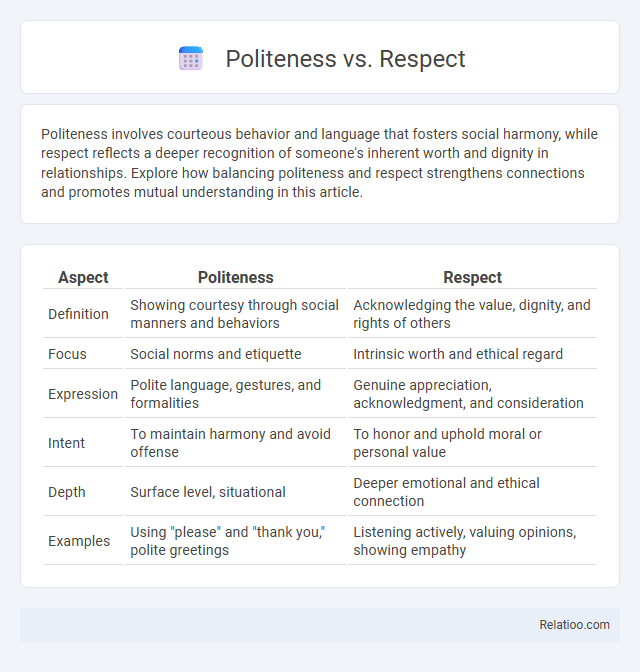Politeness involves courteous behavior and language that fosters social harmony, while respect reflects a deeper recognition of someone's inherent worth and dignity in relationships. Explore how balancing politeness and respect strengthens connections and promotes mutual understanding in this article.
Table of Comparison
| Aspect | Politeness | Respect |
|---|---|---|
| Definition | Showing courtesy through social manners and behaviors | Acknowledging the value, dignity, and rights of others |
| Focus | Social norms and etiquette | Intrinsic worth and ethical regard |
| Expression | Polite language, gestures, and formalities | Genuine appreciation, acknowledgment, and consideration |
| Intent | To maintain harmony and avoid offense | To honor and uphold moral or personal value |
| Depth | Surface level, situational | Deeper emotional and ethical connection |
| Examples | Using "please" and "thank you," polite greetings | Listening actively, valuing opinions, showing empathy |
Defining Politeness and Respect
Politeness refers to using socially accepted behaviors and language to show consideration for others' feelings, often involving manners, greetings, and courteous expressions. Respect goes deeper, encompassing a genuine recognition of another person's worth, rights, and dignity beyond superficial etiquette. Your interactions improve when you understand that politeness is about external behavior, while respect reflects sincere appreciation and value.
Cultural Perspectives on Politeness and Respect
Cultural perspectives on politeness and respect reveal distinct social norms shaping communication styles across societies. While politeness often involves adhering to local etiquette and indirect speech to avoid offense, respect typically conveys deeper recognition of authority, status, or relationships within cultural contexts. Understanding these nuances can help you navigate social interactions more effectively and foster meaningful cross-cultural connections.
The Psychological Foundations of Respect
The psychological foundations of respect lie in recognizing the intrinsic worth and dignity of others, which fosters positive social interactions and cooperation. Respect differs from politeness, as it involves genuine admiration and valuing an individual's qualities, whereas politeness often revolves around social norms and etiquette. Your understanding of these distinctions enhances emotional intelligence and improves relationship dynamics in personal and professional settings.
Politeness: Social Etiquette or Sincerity?
Politeness often embodies social etiquette, involving behaviors like using courteous language and following cultural norms to maintain harmony in interactions. However, true politeness transcends mere formality and reflects genuine sincerity, demonstrating respect and consideration for others' feelings. You can cultivate authentic politeness by balancing appropriate social conduct with heartfelt intentions, ensuring your interactions are both respectful and meaningful.
Key Differences Between Politeness and Respect
Politeness involves using socially accepted manners and language to show consideration for others, often guided by cultural norms and etiquette rules, while respect reflects a deeper recognition of someone's inherent worth and dignity regardless of social context. You can be polite without truly respecting someone, as politeness is surface-level behavior, whereas respect demands genuine acknowledgment and value of the person's feelings and rights. Understanding this key difference enhances your interpersonal communication by ensuring that actions are not only courteous but also meaningful and sincere.
When Politeness Lacks Respect: Real-World Examples
Politeness without respect often manifests in superficial or insincere interactions, such as automated customer service responses that use polite language but ignore genuine concerns, leaving You feeling undervalued. In workplace scenarios, a manager might use polite phrasing but dismiss employee input, demonstrating politeness that lacks true respect. Real-world examples highlight that respect requires acknowledging someone's dignity and worth beyond mere courteous words.
Respect Without Politeness: Is It Possible?
Respect without politeness manifests as a fundamental acknowledgment of another's value or rights, independent of courteous language or gestures. This form of respect is common in professional or hierarchical settings where genuine regard exists despite the absence of traditional politeness. Understanding respect as a deeper, principle-based attitude highlights that politeness is a social lubricant, not a necessary condition for respect itself.
The Role of Communication in Politeness and Respect
Communication plays a crucial role in expressing both politeness and respect, serving as the primary medium through which social norms and cultural values are conveyed. Politeness often involves using language strategies such as honorifics, indirect requests, and positive or negative politeness tactics to maintain social harmony and minimize face-threatening acts. Respect, while related, goes deeper in demonstrating recognition of inherent value and status, often reflected through verbal and nonverbal cues that affirm dignity and foster trust in interpersonal interactions.
Building Genuine Relationships: Beyond Surface Politeness
Building genuine relationships requires moving beyond surface politeness to foster true respect and understanding. Politeness involves courteous behavior and social norms, while respect emphasizes recognizing and valuing others' inherent worth and perspectives. Cultivating authentic connections depends on consistent respect that transcends mere polite gestures, creating deeper trust and meaningful interactions.
Fostering Respect in Personal and Professional Settings
Fostering respect in personal and professional settings involves recognizing the intrinsic value of individuals beyond surface-level politeness, emphasizing genuine understanding and appreciation of diverse perspectives and contributions. Respect builds trust and cooperation by honoring boundaries and encouraging open, honest communication, whereas politeness primarily manages social etiquette and interaction norms. Prioritizing respect creates a foundation for meaningful relationships and effective collaboration, leading to more inclusive and productive environments.

Infographic: Politeness vs Respect
 relatioo.com
relatioo.com